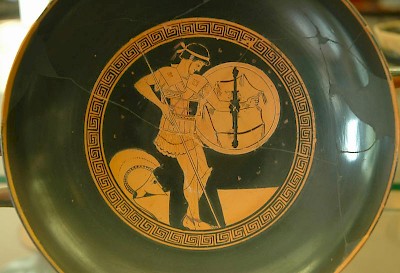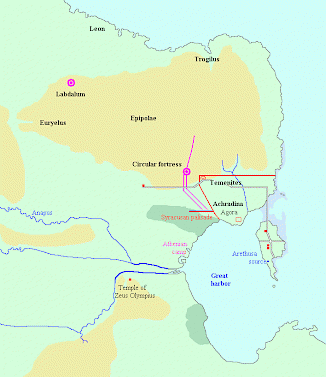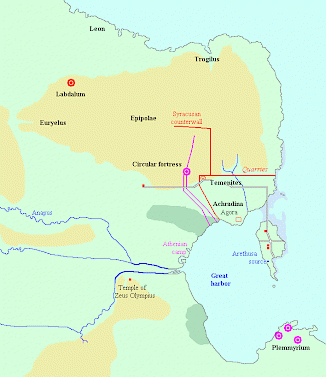Gylippus
Gylippus (Greek: Γυλιππος) : Spartan commander, famous for his exploits during the siege of Syracuse (414-413 BCE).

Gylippus was the son of a man named Cleandridas, a Spartiate, one of Sparta's elite warriors. He was also a mothax, which means that he belonged to a "second tier" of Spartan society, and suggests that his military training (agoge) had been sponsored by an influential man.
Nothing is known about Gylippus' early career, but it is probable that he gained military experience during the conflict between the Athenians and Spartans that is known as the Archidamian War (431-421). Sparta tried to force its opponent to dismantle its military alliance, the Delian League, but after ten years of war, it had to concede that the Athenians had been victorious. After the Peace of Nicias, they even launched a diplomatic offensive in the Peloponnese, but the Spartan king Agis II was able to restore Sparta's fortunes in the battle of Mantinea (418). During these events, Gylippus must have distinguished himself and gained a reputation as a capable commander.
In 415, the Athenians embarked upon an ambitious project: the conquest of Sicily. After some initial successes, they laid siege to Syracuse, the largest city on the island (414). However, its inhabitants, led by a man named Hermocrates, had prepared themselves and built a large wall to protect themselves. When the Athenian commander Nicias started the siege, he knew that he could not storm Syracuse but had to starve it. So the besiegers started to build a second wall across the Epipolae plateau, where they could block the city. The Syracusans responded by digging a trench and building a palisade through the marshy area west of their town, so that they would retain command of a road to the interior of Sicily, but the Athenians destroyed these fortifications. The besieged knew that only a miracle could save them.

And this is what happened: Gylippus landed with reinforcements from Sparta and Corinth, the mother city of Syracuse.
He had made a detour, however. Bad weather had first carried his ships to Cyrenaica, where he had supported the inhabitants of Euesperides (modern Benghazi), who were under attack by a native tribe (probably the Nasamones). After defeating them, Gylippus had gone along the coast to Tripolitana, and had crossed over to Sicily, where he had arrived at Selinus. Here, he had recruited additional soldiers.

The Spartan now occupied Euryelus, one of the few accesses to the Epipolae, marched along the still partly unfinished Athenian siege wall, and reached Syracuse. Here, he immediately ordered the defenders to build a counterwall that was to prevent the Athenians from finishing their northern wall. Nicias understood what was about to happen, but the soldiers he sent were defeated by the Syracusan cavalry and could not prevent their enemies from finishing their counterwall. From now on, it was obvious that the Athenians were unable to fully invest Syracuse, which would always be able to obtain supplies from its allies in the central and western parts of the island. As if to stress this point, Gylippus also captured the Athenian base at Labdalum.
Nicias was unable to formulate a real response. He gathered many troops in three fortresses at Plemmyrium, south of the Great Harbor. It was something of a retreat to safety and demoralized his men. Worse, obtaining fresh water was difficult, because the Syracusans were superior in cavalry. Seeing that he was no longer besieging but was being besieged, Nicias wrote a letter to Athens, asking for a recall or reinforcements.
However, it was too late. The Syracusans attacked the Athenians in the Great Harbor, and although the Athenians were victorious, Gylippus was able to occupy Plemmyrium during the naval engagement. Worse was to come: in a second naval battle, the Athenians were defeated by the Syracusans, who had fortified their ships with stay-beams, so that they could ram their enemies bow on.
Almost immediately after this defeat of the Athenians, they received reinforcements, led by Demosthenes (summer 413). He at once tried to reoccupy the Epipolae, but Gylippus and the Syracusans foiled the attack. Demosthenes now concluded that it was best to break off the siege. It was a disgrace, but it was still possible to minimize the losses. Nicias, however, was against it, and because there were reports that one of the Syracusan political factions wanted to surrender, the Athenians stayed. When Nicias finally admitted that their position was hopeless, a lunar eclipse -an evil omen- forced them to stay.
Now, Gylippus and the Syracusans blocked the entrance of the Great Harbor. The Athenians tried to break out, but were defeated in the final naval engagement, and were forced to retreat from Syracuse by land. Gylippus and Syracusans continually attacked them, and in the end, they captured all their enemies. Their victory was complete (text).
Gylippus and Hermocrates tried to prevent the execution of the Athenian generals: Hermocrates because he thought that it was decent to treat those who had been defeated with compassion, Gylippus because he wanted to bring them to Sparta. His opposition of the populace created some ill-will, and the man who had saved Syracuse was suddenly accused from all sides, and there may some truth in the charge of avarice. Many Spartans were unable to cope with the wealth they found abroad, and besides, Gylippus was a mothax, who needed money to start live up to the fame he had earned.
The charges were also known in Sparta. When Gylippus returned, he was forced to stand trial; probably, the members of the Spartan elite did not appreciate that a mere mothax eclipsed them. Gylippus' ulitmate fate is not recorded: the author Athenaeus records a tradition that he committed suicide, but the historian Diodorus of Sicily says that after the battle of Aigospotamoi, Gylippus was accused of theft, sentenced to death, and fled away from Sparta.note